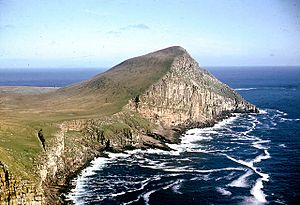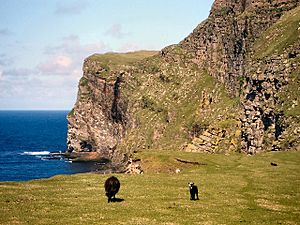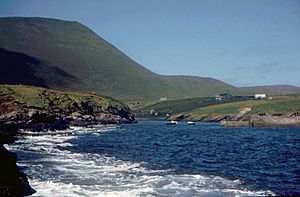Foula facts for kids
| Gaelic name | Fughlaigh |
|---|---|
| Norse name | Fugløy |
| Meaning of name | Old Norse for 'bird island' |
| OS grid reference | HT960392 |
| Coordinates | 60°07′59″N 2°04′01″W / 60.133°N 2.067°W |
| Physical geography | |
| Island group | Shetland |
| Area | 1,265 hectares (4.88 sq mi) |
| Area rank | 43 |
| Highest elevation | The Sneug 418 m (1,371 ft) |
| Administration | |
| Sovereign state | United Kingdom |
| Country | Scotland |
| Council area | Shetland Islands |
| Demographics | |
| Population | 33 |
| Population density | 3 people/km2 |
| Largest settlement | Ham |
Foula (pronounced Foo-la) is a small island in the Shetland Islands of Scotland. It's one of the most faraway islands in the United Kingdom where people live all the time. The Holbourn family has owned the island since the early 1900s. Foula was also where the famous film The Edge of the World was filmed. A large ship called RMS Oceanic was wrecked near Foula.
Contents
Discover Foula's Name
The name "Foula" comes from an old language called Old Norse. In Old Norse, "Fugley" means "bird island." This makes sense because Foula is home to many birds! You can see a similar name, "Fugloy," for an island in the Faroese language, which also means "bird island."
Exploring Foula's Geography
Foula is located in the Atlantic Ocean, about 20 kilometers (12 miles) west of Walls in Shetland. The island is roughly 4 kilometers (2.5 miles) wide and 5.5 kilometers (3.5 miles) long. It has a flat area along its east side.
Foula is the seventh largest island in the Shetland group, covering about 12.7 square kilometers (4.9 square miles). Its eastern cliffs are low, but the western cliffs are very steep, rising between 150 and 365 meters (490 and 1,200 feet) high.
The island has five main peaks. The highest point is the Sneug, which is 418 meters (1,371 feet) tall. Another peak, the Kame, is 376 meters (1,234 feet) high. In the north, you can find Gaada Stack, which is a natural rock arch. To the southwest, there's a cool crack in the cliffs called Da Sneck Ida Smaalie, which is 30 meters (98 feet) deep and only 2 meters (6.6 feet) wide.
Life on Foula Island
Foula has a small population of 38 people, who live in two main areas: Hametun and Ham. In the past, islanders earned a living by fishing for whitefish and then for lobster. Today, most people on Foula are crofters. This means they farm small pieces of land, mostly raising sheep. Many also earn money from birdwatching tourism, as the island is a great place to see birds.
Dangerous Reefs Near Foula
There's a hidden reef called the 'Hoevdi Grund' or the Shaalds o' Foula. It's about 3 kilometers (1.9 miles) east of Foula, between the island and the Shetland mainland. The tides here can be very strong, reaching up to 12 knots (22 km/h or 14 mph). This reef is very close to the surface, making it dangerous for ships.
Getting to and From Foula
A company called BK Marine Limited runs a ferry service from Ham on Foula to Walls and Scalloway on the Shetland Mainland. The ferry, named New Advance, can carry up to 12 passengers. The trip takes about two hours. There are also flights from Foula's airstrip to Tingwall Airport.
Foula doesn't have many sheltered spots for boats. The only beach is at the end of Ham Voe on the east coast. Local boats, including the mail boat, are pulled out of the water when not in use.
Wildlife on Foula
The island's tall cliffs, which are up to 370 meters (1,210 feet) high, are home to many different kinds of birds. You can find Arctic terns, red-throated divers, and large great skuas nesting here.
Foula's Fascinating History
Ancient Times on Foula
People first lived on Foula about 5,000 years ago. Between 2006 and 2008, a group called the Bath & Camerton Archeological Society visited Foula to study ancient standing stones. In 2006, they found a special stone circle at Da Heights in northern Foula. Further study in 2007 showed that this stone circle was built by humans. It was shaped like an oval, with its longest side pointing towards the mid-winter solstice. It was built before 1000 BC.
Foula's Past: 15th to 19th Centuries
In 1490, the Ciske family's lands were divided. Foula and another island called Vaila became the property of Alv Knutsson. However, the Ciskes were Norwegian, and Scotland had taken over Shetland a few decades earlier. This led to confusion and arguments about who truly owned the island.
Foula kept using the old Julian calendar even when the rest of Great Britain switched to the Gregorian calendar in 1752. Foula kept 1800 as a leap year, but it did not have a leap year in 1900. Because of this, Foula is now one day ahead of the Julian calendar and 12 days behind the Gregorian calendar. This means they celebrate Christmas Day on January 6th and New Year on January 13th (according to the Gregorian calendar).
In 1720, a terrible smallpox disease hit Foula. About 200 people lived there at the time. Because the islanders were so cut off from the outside world, they had no natural protection against smallpox, unlike most people in Northern Europe. Sadly, nine out of ten people on the island died during this epidemic.
The writer John Sands lived on Foula and Papa Stour in the late 1800s. He strongly opposed the unfair "truck system," where workers were paid with goods instead of money. He even drew cartoons to show how bad it was. In one cartoon, he drew Foula as a beautiful young woman being squeezed by a snake labeled 'landlordism,' while other creatures like 'missionary' and 'laird' watched.
Foula was one of the last places where the Norn language was spoken. This old language was similar to Old Norse. The way people speak on Foula today is still very much influenced by Old Norse.
Foula in the 20th Century
Professor Ian S. Holbourn, who was the 'Laird' (landowner) of Foula, wrote about a disaster on September 8, 1914. The large ship RMS Oceanic hit the Shaalds o' Foula and became a wreck within two weeks. Professor Holbourn was very lucky with ship travel. The next May, he was on the RMS Lusitania when it sank, but he survived that too!
The professor's grandson, Robert Holbourn, who designed ships, was the island's "Peat Marshal" for many years. Peat is a very important and rare resource on Shetland, used for heat and fuel. Cutting peat needs a lot of skill and takes years to learn. The best islanders are known as the 'Cutters.' Following a long-standing tradition on Foula, all able-bodied men sometimes help women who don't have a 'cutter' in their household to cut peat.
Simon Martin, who lived on Foula for five years while dealing with the wrecked Oceanic, described the island like this:
- "Foula, also known as Ultima Thule (meaning 'farthest land') since Roman times, rises steeply from the water. From the Shetland mainland, its five peaks – the Noup, Hamnafield, the Sneug, Kame, and Soberlie – stand out clearly. The cliffs on the west side are among the highest sheer cliffs in Britain, towering 1,200 feet (365 meters) straight up from the sea.
- "Foula, or Fughley as it was once called, means 'Bird Island.' About half a million birds of different types share the island's rocky surface with the people. Most of the island's surface is a peat bog on rock."
A lighthouse was built at the southern tip of Foula in 1986. It was first powered by gas, but now it uses solar and wind power.
Foula's Culture and Arts
Religion on Foula
Many people on Foula attend a Presbyterian church called Foula Kirk or Baxter Chapel. It is part of the Church of Scotland. The church is made of grey stone and is located near Hamnafield.
Foula in Film
- The Edge of the World (1937) is a film directed by Michael Powell. It tells a story based on real events: the evacuation of the last 36 people from the remote island of St Kilda in 1930. St Kilda is in the Atlantic Ocean, about 64 kilometers (40 miles) west-northwest of North Uist. The people there spoke Gaelic. Michael Powell couldn't get permission to film on St Kilda. So, he filmed the movie over four months in the summer of 1936 on Foula instead. The islanders on Foula speak the Shetland dialect.
- Return To The Edge Of The World (1978) is a documentary. It shows the cast and crew of the 1937 film reuniting 40 years later and visiting Foula again.
Foula's Traditions and Celebrations
The people of Foula still keep many old Norse traditions, including their folklore and celebrations. They continue to use the Julian calendar for Christmas. All the islanders gather in one house on January 6th to celebrate Christmas Day, even though it's a day later than the rest of the world. New Year's Day falls on January 13th for them.
Poetry Inspired by Foula
The poet Vagaland wrote a poem called Da Sang o da Papa men about the fishermen of Papa Stour. It has a repeating line, "Rowin Foula Doon." This refers to how fishermen would row their open boats out to sea until the high cliffs of Foula could no longer be seen. This meant their boat was about 96 kilometers (60 miles) west of Papa Stour! The traditional song "Hildina" was collected on Foula in 1774. It is the only surviving poem written in the Norn language.
Foula's Role in Mapping
The Sneug peak on Foula was used as the starting point (or meridian) for the 6-inch and 1:2500 Ordnance Survey maps of Orkney and Shetland. This means it was a key reference point for creating these detailed maps.
See also
 In Spanish: Foula para niños
In Spanish: Foula para niños





